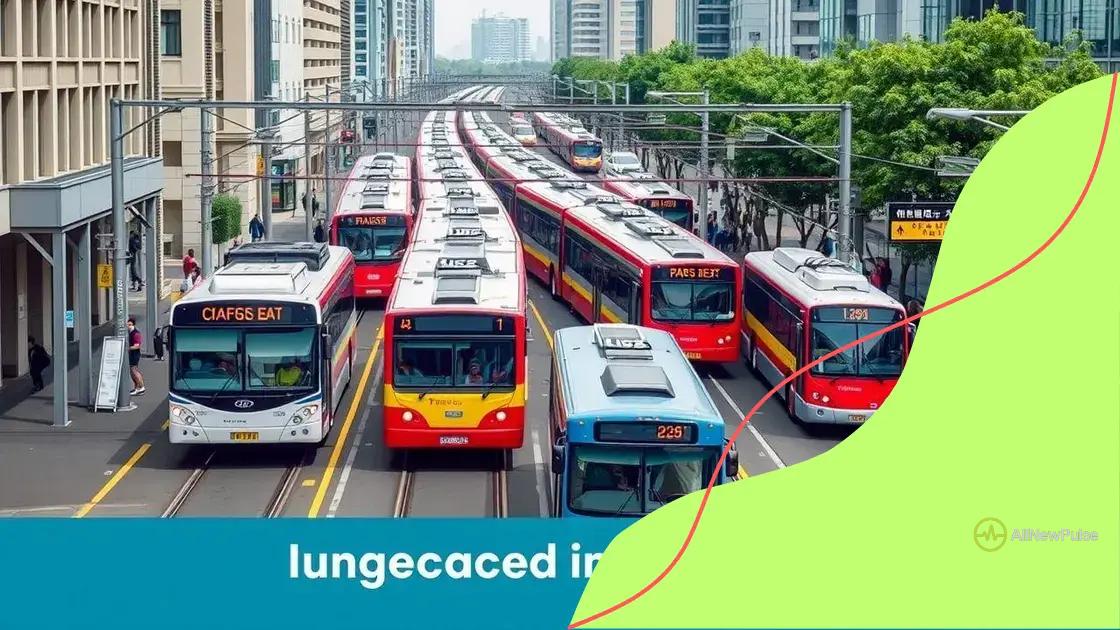The future of transportation and infrastructure: what to expect

Smart cities leverage technology and sustainable practices to enhance urban living, focusing on connectivity, data-driven decision making, and eco-friendly designs to improve quality of life and resource management.
The future of transportation and infrastructure is shaping up to be exciting and full of possibilities. Have you ever wondered how new technologies will change the way we travel and live? Let’s explore what lies ahead!
Emerging trends in transportation technology
Transportation technology is undergoing rapid changes that can have a significant impact on how we move from one place to another. Emerging trends in this field are revolutionizing our daily commutes and logistics. With the growing concern for the environment, innovations are focused on sustainability and efficiency.
Electric and Autonomous Vehicles
One of the most exciting developments is the rise of electric vehicles (EVs). These vehicles are not only environmentally friendly but also cost-effective in the long run. As battery technology advances, EVs are becoming more accessible to the public.
Moreover, autonomous vehicles are quickly moving from being a concept to reality. Companies are testing cars that can drive themselves, promising to reduce traffic accidents and increase road safety.
Connected Transportation Systems
Another trend is the integration of technology into transportation systems. Connected vehicles can communicate with each other and traffic signals. This enhances traffic flow and reduces congestion on busy roads.
- Enhanced safety features through communication
- Optimized traffic management
- Faster response times for emergency services
Mobility as a Service (MaaS) is also gaining popularity. This approach combines various transport services into a single accessible on-demand platform. Users can plan journeys that may include various transport modes, such as buses, trains, and ridesharing, all from one app.
The adaptation of smart technologies is changing the landscape. Sensors on roads can monitor traffic conditions, leading to better infrastructure planning and improved travel experiences.
Blockchain Technology in Transportation
Blockchain is another innovation that is making waves in the transport sector. It provides transparency and enhances security in logistics. Tracking shipments in real-time has never been easier, thanks to this technology.
With the combination of these trends, the future of transportation looks promising. By embracing technology, we can create safer, more efficient, and more sustainable modes of transport. Each emerging trend is paving the way for an interconnected system that prioritizes both convenience and the environment.
As we explore these advancements, it’s exciting to think about how they might shape our cities and lifestyles in the near future. The future of transportation is bright and full of potential.
Sustainable infrastructure solutions
Sustainable infrastructure solutions are essential for tackling today’s environmental challenges. As urban areas expand, the need for eco-friendly approaches to infrastructure has never been more critical. By prioritizing sustainability, cities can enhance the quality of life for their residents while preserving natural resources.
Green Building Practices
One major aspect of sustainable infrastructure is the use of green building practices. This includes utilizing materials that are environmentally friendly and energy-efficient. Buildings designed with these principles can significantly reduce energy consumption and waste.
- Use of recycled materials
- Installation of energy-efficient appliances
- Incorporation of renewable energy sources
Such practices not only lessen environmental impact but also lower operating costs in the long run.
Public Transportation Development
Another vital area is enhancing public transportation systems. By promoting the use of buses, trains, and bicycles, cities can minimize traffic congestion and pollution. A reliable public transit system encourages people to opt for greener travel options.
Smart transit solutions, like real-time tracking and mobile apps, make public transportation even more appealing. These advancements improve accessibility and user experience, fostering greater community involvement.
Integrating nature into urban designs is also critical, which can take the form of parks, green roofs, and urban gardens. These solutions not only beautify the city but also provide residents with spaces to relax and connect with nature. They can also help absorb carbon dioxide and filter pollutants, leading to improved air quality.
Water Management Systems
Efficient water management is another crucial component of sustainable infrastructure. Infrastructure that captures and recycles rainwater can reduce reliance on traditional water supply systems. Additionally, sustainable drainage systems can minimize flooding and prevent water pollution.
Implementing these solutions creates a more resilient and adaptable urban environment. As cities move towards sustainable solutions, they can ensure a healthier future for all residents. Combining innovative technology and eco-conscious practices paves the way for sustainable growth and development.
The role of public transportation in urban planning

The role of public transportation in urban planning is vital for creating sustainable and efficient cities. It provides residents with accessible options to travel while reducing reliance on personal vehicles. By integrating effective public transit systems into urban design, cities can alleviate congestion and minimize environmental impact.
Enhancing Accessibility
Public transportation enhances accessibility for all demographics. It allows people without access to cars, such as students, the elderly, and low-income individuals, to reach jobs, education, and services. When cities invest in reliable public transport, they open doors to opportunities for everyone.
- Bus and train networks that connect communities
- Improved access to medical facilities
- Reliable options for daily commuting
Increased accessibility not only boosts individual mobility but also promotes economic growth within urban areas by making it easier for businesses to reach their customers.
Reducing Traffic Congestion
Another significant benefit is the ability of well-planned public transportation systems to reduce traffic congestion. By providing convenient alternatives to driving, cities can limit the number of vehicles on the road. This, in turn, leads to less pollution and lower greenhouse gas emissions.
With targets to reduce carbon footprints, cities are exploring options like dedicated bus lanes and bike-sharing programs. Such solutions encourage residents to leave their cars at home, contributing to smoother traffic flow.
Integrating Land Use and Transportation
Urban planners are increasingly recognizing the importance of integrating land use with transportation planning. By designing neighborhoods around transit hubs, cities can promote increased public transportation usage. Mixed-use developments, where residential areas exist near transit stations, encourage more people to rely on public transit.
This strategy not only promotes vibrant community spaces but also helps support local businesses. As pedestrian-friendly areas develop around transit options, residents find it easier to walk or bike to their destinations.
Investing in public transportation infrastructure is essential for modern urban planning. It fosters sustainability, enhances accessibility, and improves the quality of life for residents. Public transit creates a network of connected communities where individuals can thrive without the limitations of car dependence.
Impact of autonomous vehicles on society
The impact of autonomous vehicles on society is a topic of great interest and discussion. As technology advances, self-driving cars promise to revolutionize the way we travel. These vehicles offer many potential benefits, from increased safety to improved traffic efficiency.
Enhancing Road Safety
One of the primary advantages of autonomous vehicles is their potential to enhance road safety. Human error is a leading cause of traffic accidents. By utilizing advanced sensors and algorithms, self-driving cars can significantly reduce the likelihood of collisions.
- Real-time data processing for immediate responses
- Improved awareness of surroundings
- Minimized driver distractions
With increased safety measures, communities may experience fewer accidents and related fatalities. This can lead to a more secure environment for all road users.
Impact on Traffic Flow
Another significant impact of autonomous vehicles is their ability to optimize traffic flow. These vehicles communicate with each other and traffic signals to reduce congestion. They can adjust speeds and routes dynamically, enhancing overall efficiency on the roads.
The introduction of smart traffic systems can complement self-driving technology. Traffic jams could become less common, allowing for smoother travel and reduced travel times for everyone.
As traffic flow improves, carbon emissions may also decrease. This can contribute to cleaner urban environments and a healthier climate.
Changes to Urban Planning
Autonomous vehicles will likely influence urban planning and development. With fewer parking spaces needed, cities can repurpose these areas for parks, green spaces, or housing. This shift opens the opportunity for more walkable and bike-friendly environments.
Furthermore, the accessibility of autonomous vehicles can lead to increased mobility for individuals who cannot drive, such as the elderly or disabled. Providing these communities with greater independence enhances their quality of life.
The potential societal changes brought on by autonomous vehicles are far-reaching. As we embrace this technology, we need to consider both the benefits and challenges it presents. Ensuring effective regulations and infrastructure will be crucial to fully realize the advantages that self-driving cars can offer.
Smart cities and their design principles
Smart cities represent a new wave in urban development, focusing on integrating technology and sustainable practices into their design. These cities aim to improve the quality of life for residents while efficiently managing resources. The design principles of smart cities emphasize connectivity, sustainability, and data utilization.
Connectivity and Communication
At the heart of smart cities is the principle of connectivity. By utilizing the Internet of Things (IoT), different systems within the city communicate with each other. This interconnectedness enables real-time data sharing, which can optimize traffic management, energy use, and public services.
- Smart traffic lights adjust to real-time traffic conditions.
- Connected public transportation systems provide timely updates to users.
- Public Wi-Fi networks support communication and accessibility.
This effective communication leads to a smoother flow of information, benefiting both residents and city officials.
Sustainable Urban Design
Smart cities prioritize sustainability in their urban design. Buildings and infrastructure are created with eco-friendly materials and energy-efficient systems. By integrating green spaces and promoting public transport, these cities reduce their environmental footprint.
Renewable energy sources, such as solar panels and wind turbines, play a crucial role in powering city services. This focus on sustainability not only conserves resources but also enhances the health and well-being of citizens.
Data-Driven Decision Making
Another vital principle is data-driven decision-making. Smart cities collect data through sensors and devices deployed throughout the urban landscape. This data informs city planners and officials about patterns and needs within the community, enabling more informed and effective governance.
For instance, analyzing traffic data helps in planning road improvements, while monitoring air quality can lead to initiatives aimed at reducing pollution. This proactive approach aims to create a safer and more efficient urban environment for all.
As we move towards a future with smart cities, the importance of integrating technology and sustainability cannot be overstated. These principles guide urban development, ensuring cities not only meet the needs of their residents but also contribute to a sustainable future.
In conclusion, smart cities are set to transform urban living by integrating advanced technology with sustainable practices. The principles of connectivity, sustainability, and data-driven decision-making are essential for creating urban environments that benefit everyone. Embracing these principles not only enhances quality of life but also prepares cities for future challenges. As we continue to develop smart cities, collaboration among government, businesses, and communities will be vital to ensure these urban areas thrive and adapt over time.
FAQ – Frequently Asked Questions About Smart Cities
What defines a smart city?
A smart city integrates advanced technology and data to enhance urban living, improving services like transportation, energy management, and public safety.
How does connectivity improve urban living?
Connectivity in smart cities allows for real-time data sharing, leading to more efficient public services and better communication between city systems.
What are the benefits of sustainable practices in smart cities?
Sustainable practices reduce the environmental impact of urban areas, promote green spaces, and enhance residents’ quality of life.
Why is data-driven decision making important in urban planning?
Data-driven decision making helps city planners understand community needs, allowing for informed decisions that improve infrastructure and services.





